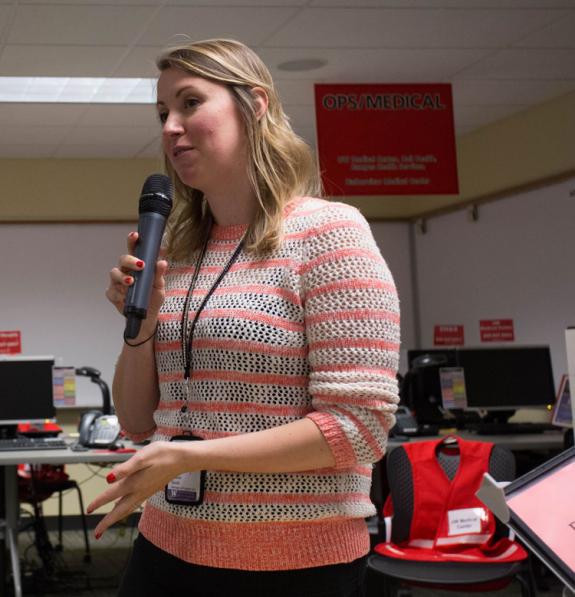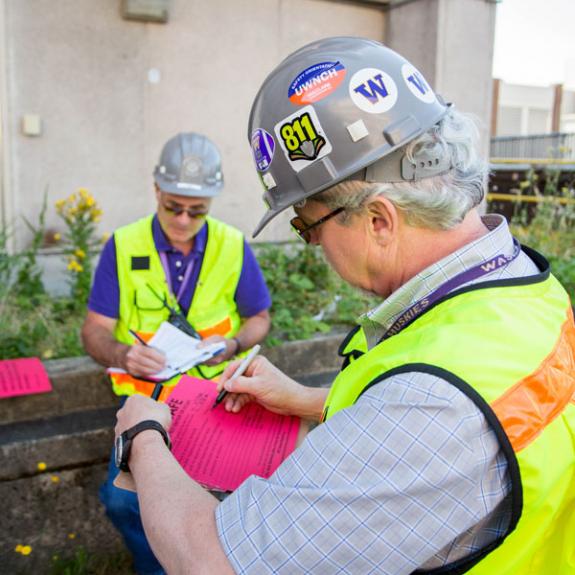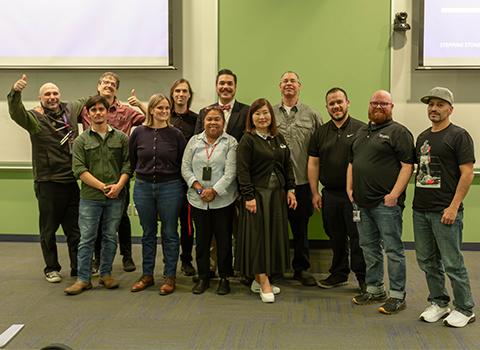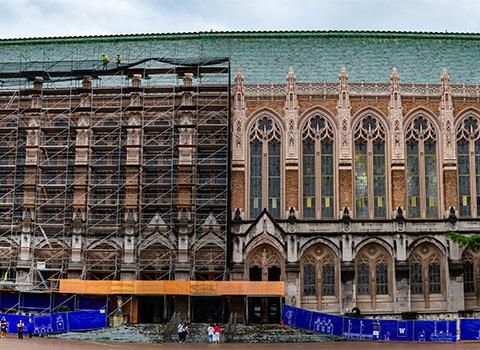Cascadia Rising at UW

Structural Engineer KC Chen (left) and Civil Engineer Jim Morin (right) put up a red sign, indicating a building is unsafe to enter, after a mock inspection as a part of the Cascadia Rising regional earthquake preparedness drill.
The zipping-sound of a duct tape roll is cut off by the beeping of a radio. Employees mill about, some in Tyvek suits on an 80-degree day, others wearing high-visibility gear and hard hats. A 9.0 magnitude earthquake hit at 8:08 a.m., but luckily chaos hasn’t ensued because it’s just a drill.
As government agencies across three states participated in the regional Cascadia Rising earthquake preparedness exercise, the University of Washington took the opportunity to test coordination between its emergency response teams across campus. It’s one of only two universities participating in the state.
“Our new Seismic Resilience Program Manager Stacie Smith originally asked the question,” said Emergency Management Director Steve Charvat. “We’ve got these great response teams who do amazing work, but do they talk to each other? Do they talk to Emergency Management?”
Staff from Emergency Management, a Facilities Services department, will spend the rest of the week working with the City of Seattle, King County, the City of Renton and City of Mercer Island on their Emergency Operations Center responses.
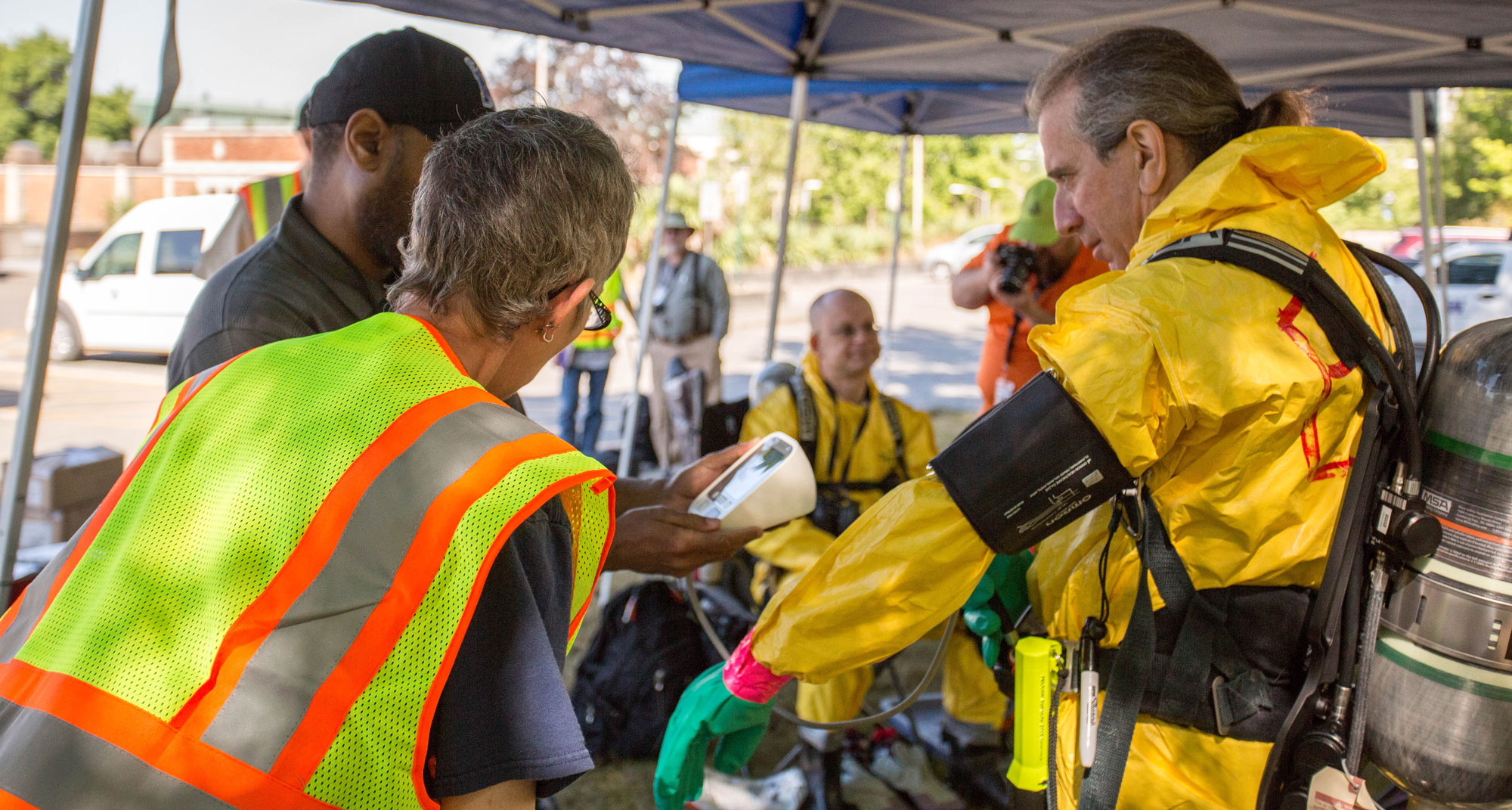
Emergency response teams at the University of Washington gear up in hazmat suits and other personal protective equipment for the Cascadia Rising earthquake drill.
AFTER THE BIG ONE
AFTER THE BIG ONE
Three response teams participated in this week’s Cascadia Rising drill alongside Emergency Management: Facilities Services’ Campus Engineering, who staffs what’s called an Applied Technology Council – 20 (ATC-20) team; Environmental Health & Safety’s Pre-Entry Assessment Team (PEAT); and a team specific to the University’s myriad of labs.
The ATC-20 team is responsible for structurally assessing buildings after an earthquake, and posting whether or not they are safe to go inside. The team works hand-in-hand with PEAT, who ensures that there are no chemical releases inside a building. PEAT was created in response to lessons learned after the Nisqually earthquake in 2001.
In an emergency, such as a large earthquake, cell phone service will be scant. The teams rely on radios to contact and coordinate activities to inspect and post the status of campus buildings immediately after the quake. Field teams report back to their bases, who then report to the University’s Emergency Operations Center where officials can better coordinate details and plan for next steps.
After the 9.0 magnitude earthquake Tuesday morning, ATC-20 engineers inspected the outsides of buildings and their entrances, then reported back to the EOC. After the engineers completed their inspection, EH&S’ PEAT team could inspect the inside of a building for chemical releases. After PEAT reported their results, engineers could inspect the building’s insides for structural damage.
This three-part process, while a bit repetitive, helps to ensure that PEAT personnel don’t go inside a structurally deficient building, and that ATC-20 engineers aren’t exposed to hazardous chemicals. It’s in place to help keep University employees, and the University community, safe.
“Our assessment isn’t just the building itself, but how to get in and out of it. Students, faculty and staff are going to want to get in to get their stuff, phones and everything. It becomes really critical that we get to these buildings and post their status. Some buildings have multiple entrances, including loading docks,” said Structural Engineer and ATC-20 team lead Tom Pittsford.
After inspecting a building, engineers fill out a green, yellow or red placard and place it on the building’s entrance.
“There are three ratings—green, yellow and red,” said Civil Engineer and ATC-20 team member Jim Morin. “Green means it’s safe to go in; yellow means it’s conditionally safe, there might be a specific area that needs to be avoided; and red means you can’t get inside.”
The team can also place caution tape and additional signs in what can be a tricky job.
“There could be hazards posed on the outside of the building, such as bricks or parapets that could fall more than 20’ from the building’s door,” said Morin. “We have to tape and post far enough away so that people stay away from any potential hazards.”
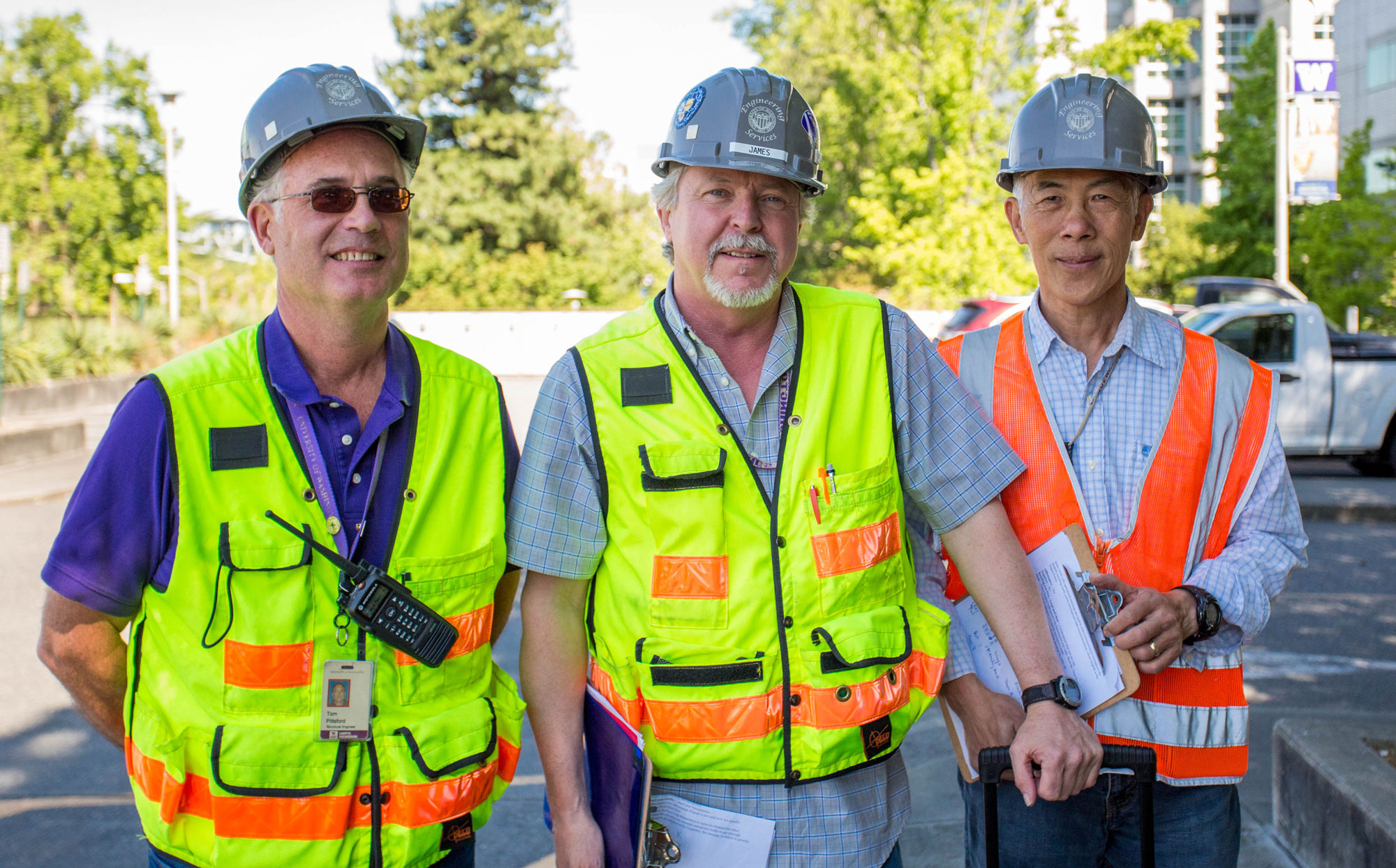
Campus engineers, and members of the ATC-20 team, Tom Pittsford (left), Jim Morin (center) and KC Chen (right) pose for a team photo before going out to inspect buildings as a part of the University's participation in the regional Cascadia Rising earthquake preparedness drill.
ATC-20 ENGINEERS
ATC-20 ENGINEERS
While Facilities Services’ Campus Engineering only has two structural engineers on staff, it has nearly 20 civil, electrical and mechanical engineers, architects, tradespeople and technicians trained in the ATC-20 standards. After an earthquake, all trained ATC-20 staff form into groups of four, each with a variety of engineers represented, and set out to inspect campus’ hundreds of buildings and structures.
“There are only a few hundred certified structural engineers in the Seattle-Tacoma-Everett metro area,” said Structural Engineer and ATC-20 team member KC Chen. “Think of all of the things structural engineers will have to inspect after an earthquake—bridges, roadways, tunnels, power plants, buildings… everything! For our campus, it’s just Tom and I, so it’s good that we have training and drills in place so that we can get to more buildings quickly.”
The Applied Technology Council, the team’s namesake, is a non-profit that has established industry standards and procedures for engineers to follow in emergency situations such as an earthquake.
“We do a separate ATC-20 drill every year,” said Pittsford. “We place photos around campus and put mock damage on the building and have our teams practice the procedures. This Cascadia Rising drill today is more focused on communication and coordination with other teams.”
Each team is equipped with a pre-packed backpack containing caution tape, posting placards, an ATC field manual, flashlights, gloves, masks, safety glasses, ATC 20 forms, clipboards and writing implements, copies of placards and evaluation forms, a campus map and a UW building inventory with priority lists.
Once at a building, the team looks specifically for six things:
- Has the building collapsed, partially collapsed or moved off its foundation?
- Is the building or one story of it noticeably leaning?
- Has the wall moved horizontally so that its top is not square with its base? Is there obvious severe damage and distress?
- Are bricks or masonry falling or likely to fall from a parapet, chimney or other feature?
- Is there severe ground or slope movement?
- Are there other hazards such as gas leaks, power lines down etc.?
Read more about the ATC-20’s yearly inspection drill on the UW Today blog.
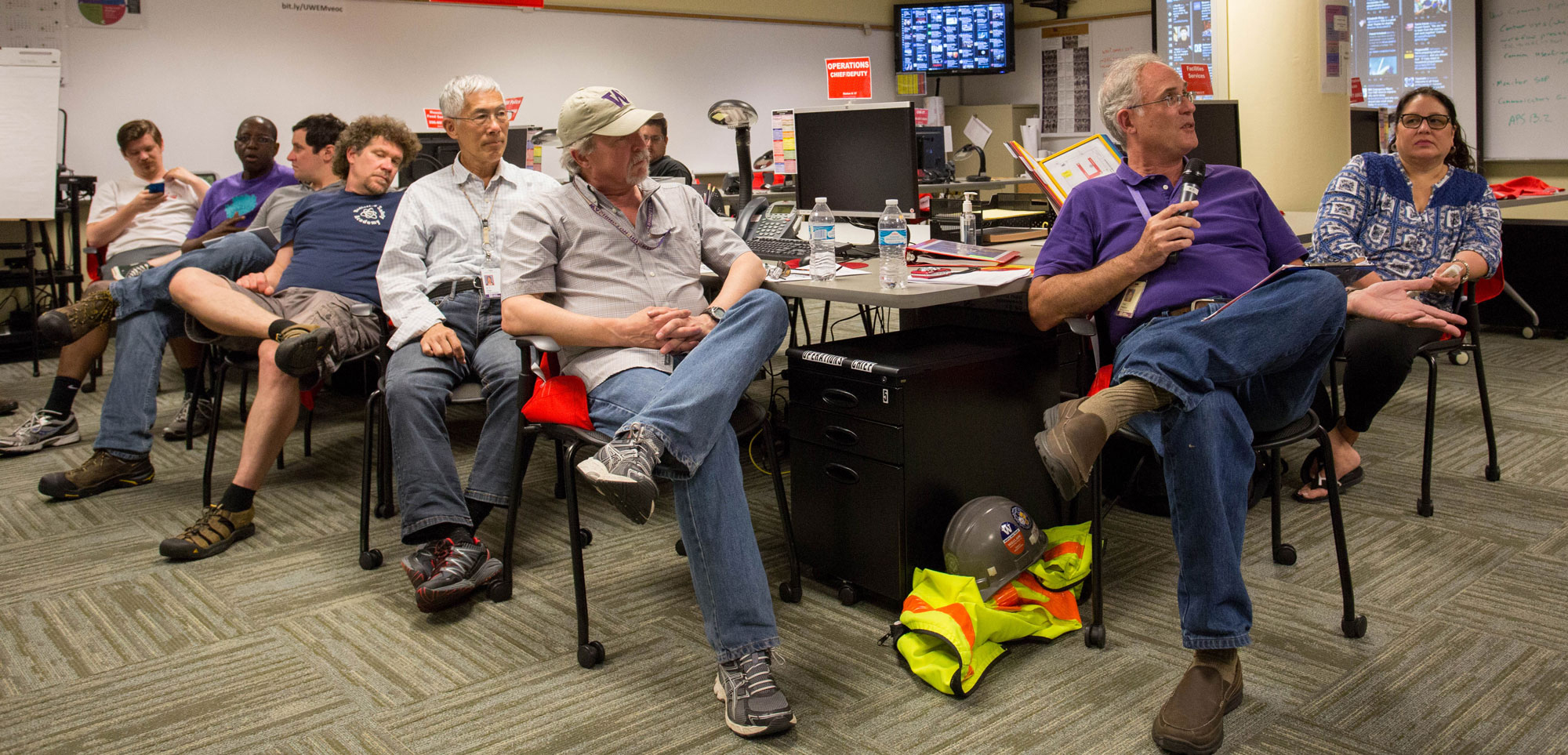
Drill participants from the ATC-20 team, PEAT, and lab response teams gather in the University's Emergency Operations Center to collect feedback and lessons they learned in the drill that might improve their efforts during a real earthquake.
The team is always looking for ways to improve their processes so they can better respond to an emergency. Eight years ago Campus Engineering and Emergency Management received a grant to purchase and place steel containers outside of their building to house the team’s pre-packed bags and other emergency response equipment. This allows the team to proceed with responding without having to inspect their own building first.
The ATC-20 team includes Structural Engineers KC Chen and Tom Pittsford; Mechanical Engineers YL Chan, Joe Cook, Bill Earhart, Brett Magnuson and Alex Wilson; Electrical Engineers Tony Fragada and Fred Pitz; Civil Engineer Jim Morin; Environmental Engineer Dave Ogrodnik; Architects Tom Berg and Jyoti Naik; GIS Analysts Cesar Escobar and Jay Dahlstrom; and Engineering Managers Robbie Avila and Ali Ferdos.
Emergency Management includes Director Steve Charvat, Plans & Training Manager Siri McLean, Business Continuity Manager Scott Preston, and Seismic Resilience Program Manager Stacie Smith.
